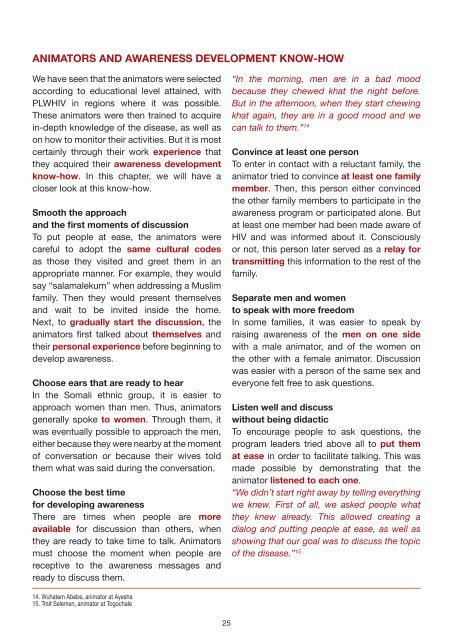Anchoring Awareness in the Community - Handicap International
Anchoring Awareness in the Community - Handicap International
Anchoring Awareness in the Community - Handicap International
You also want an ePaper? Increase the reach of your titles
YUMPU automatically turns print PDFs into web optimized ePapers that Google loves.
ANIMATORS AND AWARENESS DEVELOPMENT KNOW-HOW<br />
We have seen that <strong>the</strong> animators were selected<br />
accord<strong>in</strong>g to educational level atta<strong>in</strong>ed, with<br />
PLWHIV <strong>in</strong> regions where it was possible.<br />
These animators were <strong>the</strong>n tra<strong>in</strong>ed to acquire<br />
<strong>in</strong>-depth knowledge of <strong>the</strong> disease, as well as<br />
on how to monitor <strong>the</strong>ir activities. But it is most<br />
certa<strong>in</strong>ly through <strong>the</strong>ir work experience that<br />
<strong>the</strong>y acquired <strong>the</strong>ir awareness development<br />
know-how. In this chapter, we will have a<br />
closer look at this know-how.<br />
Smooth <strong>the</strong> approach<br />
and <strong>the</strong> first moments of discussion<br />
To put people at ease, <strong>the</strong> animators were<br />
careful to adopt <strong>the</strong> same cultural codes<br />
as those <strong>the</strong>y visited and greet <strong>the</strong>m <strong>in</strong> an<br />
appropriate manner. For example, <strong>the</strong>y would<br />
say “salamalekum” when address<strong>in</strong>g a Muslim<br />
family. Then <strong>the</strong>y would present <strong>the</strong>mselves<br />
and wait to be <strong>in</strong>vited <strong>in</strong>side <strong>the</strong> home.<br />
Next, to gradually start <strong>the</strong> discussion, <strong>the</strong><br />
animators first talked about <strong>the</strong>mselves and<br />
<strong>the</strong>ir personal experience before beg<strong>in</strong>n<strong>in</strong>g to<br />
develop awareness.<br />
Choose ears that are ready to hear<br />
In <strong>the</strong> Somali ethnic group, it is easier to<br />
approach women than men. Thus, animators<br />
generally spoke to women. Through <strong>the</strong>m, it<br />
was eventually possible to approach <strong>the</strong> men,<br />
ei<strong>the</strong>r because <strong>the</strong>y were nearby at <strong>the</strong> moment<br />
of conversation or because <strong>the</strong>ir wives told<br />
<strong>the</strong>m what was said dur<strong>in</strong>g <strong>the</strong> conversation.<br />
Choose <strong>the</strong> best time<br />
for develop<strong>in</strong>g awareness<br />
There are times when people are more<br />
available for discussion than o<strong>the</strong>rs, when<br />
<strong>the</strong>y are ready to take time to talk. Animators<br />
must choose <strong>the</strong> moment when people are<br />
receptive to <strong>the</strong> awareness messages and<br />
ready to discuss <strong>the</strong>m.<br />
“In <strong>the</strong> morn<strong>in</strong>g, men are <strong>in</strong> a bad mood<br />
because <strong>the</strong>y chewed khat <strong>the</strong> night before.<br />
But <strong>in</strong> <strong>the</strong> afternoon, when <strong>the</strong>y start chew<strong>in</strong>g<br />
khat aga<strong>in</strong>, <strong>the</strong>y are <strong>in</strong> a good mood and we<br />
can talk to <strong>the</strong>m.” 14<br />
Conv<strong>in</strong>ce at least one person<br />
To enter <strong>in</strong> contact with a reluctant family, <strong>the</strong><br />
animator tried to conv<strong>in</strong>ce at least one family<br />
member. Then, this person ei<strong>the</strong>r conv<strong>in</strong>ced<br />
<strong>the</strong> o<strong>the</strong>r family members to participate <strong>in</strong> <strong>the</strong><br />
awareness program or participated alone. But<br />
at least one member had been made aware of<br />
HIV and was <strong>in</strong>formed about it. Consciously<br />
or not, this person later served as a relay for<br />
transmitt<strong>in</strong>g this <strong>in</strong>formation to <strong>the</strong> rest of <strong>the</strong><br />
family.<br />
Separate men and women<br />
to speak with more freedom<br />
In some families, it was easier to speak by<br />
rais<strong>in</strong>g awareness of <strong>the</strong> men on one side<br />
with a male animator, and of <strong>the</strong> women on<br />
<strong>the</strong> o<strong>the</strong>r with a female animator. Discussion<br />
was easier with a person of <strong>the</strong> same sex and<br />
everyone felt free to ask questions.<br />
Listen well and discuss<br />
without be<strong>in</strong>g didactic<br />
To encourage people to ask questions, <strong>the</strong><br />
program leaders tried above all to put <strong>the</strong>m<br />
at ease <strong>in</strong> order to facilitate talk<strong>in</strong>g. This was<br />
made possible by demonstrat<strong>in</strong>g that <strong>the</strong><br />
animator listened to each one.<br />
“We didn’t start right away by tell<strong>in</strong>g everyth<strong>in</strong>g<br />
we knew. First of all, we asked people what<br />
<strong>the</strong>y knew already. This allowed creat<strong>in</strong>g a<br />
dialog and putt<strong>in</strong>g people at ease, as well as<br />
show<strong>in</strong>g that our goal was to discuss <strong>the</strong> topic<br />
of <strong>the</strong> disease.” 15<br />
14. Wuhatem Abebe, animator at Ayesha<br />
15. Trsit Selemen, animator at Togochale<br />
25

















